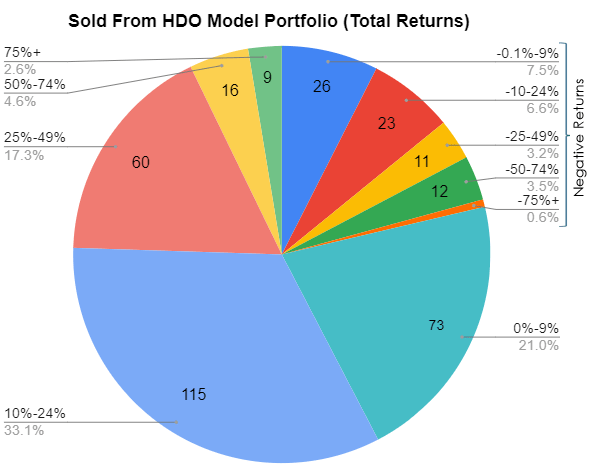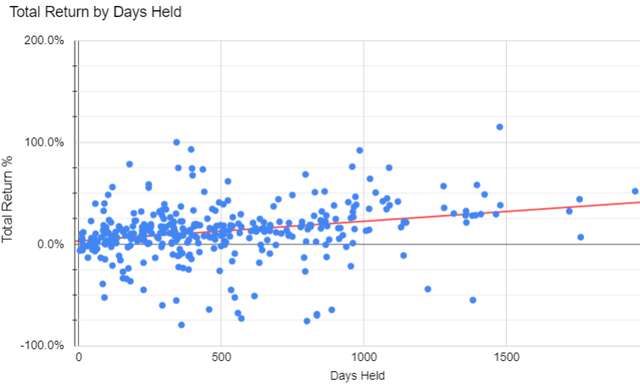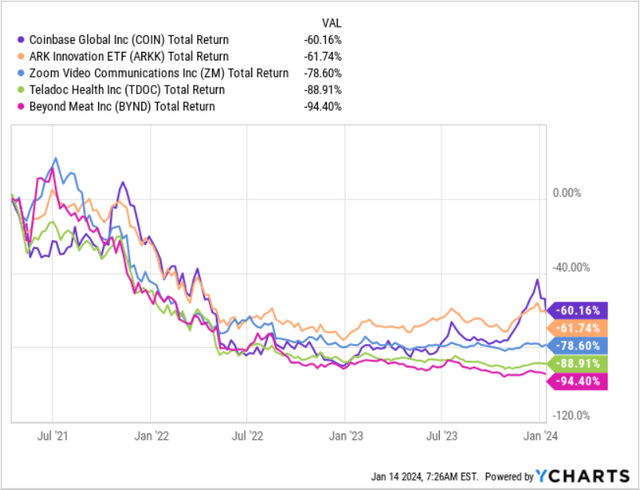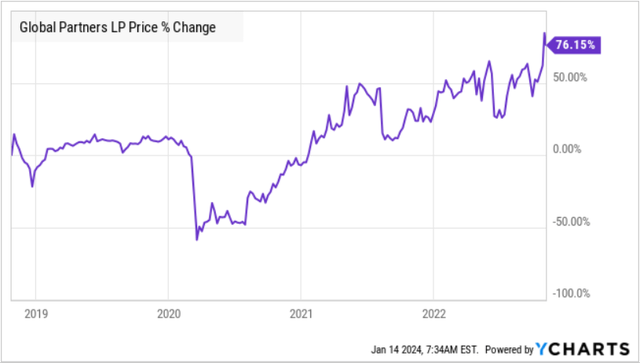Market Outlook: A Look At HDI's Total Return
We welcome new subscribers that have recently joined us. The following is the "quick link" to our live google sheet:
Summary
- We discusses the importance of focusing primarily on income rather than share prices in our investment strategy.
- The data on the HDI Model Portfolio's history shows that while approximately 20% of investments resulted in losses, the frequency and size of gains were greater.
- We emphasize the need for realistic expectations and the understanding that investments will have both gains and losses in a diversified portfolio.
= = = =
Good Morning HDI!
For the Market Outlook this week, I want to focus on HDI and the Income Method. The other week, we published an article about the inherent volatility of stocks. One reason we focus on the income an investment is producing is that income tends to be less volatile than share prices. We don't worry about the total returns at random points throughout our holding period for an investment. We know that "total return" is highly dependent upon the price when you sell. It can and will vary significantly over short periods.
So today, we take a look at HDI's history. We look at the actual realized total returns of our investments. The losses and the gains at the end of the investment, whether we sold or the shares were taken from us through a call or acquisition. We are not looking at any currently owned investments, which have not reached the finish line for better or worse – only the investments where we realized a gain or a loss, and the total return can now be calculated.
Realistic Expectations
It is important to have realistic expectations. The reality of investing in the stock market is that not every investment is going to be a "winner". Sometimes, you will realize a capital loss. How frequently and how large of capital losses you realize will depend on your investment style. If you have an investment style where you are frequently trading and you use things like stop loss orders, you will have smaller average losses. After all, if you automatically sell any stock that declines 10%, you won't have many 20%+ losses because your stop loss would kick in. However, what you would have is a lot of 10%ish losses as you would frequently be selling at a 10% loss even in scenarios where the stock later recovers.
Similarly, a very active trading strategy might result in many gains, but those gains might be smaller on average because you are selling more frequently.
With a buy-and-hold type of strategy, you will see much larger gains as you have provided time for a stock to go up and/or for you to collect dividends. However, such strategies can also lead to some large losses as you hold declining stocks much longer than a trader might.
The Income Method is a strategy where we focus on the income, not the share price. As a method of dealing with stock market volatility, the income method focuses on the income that an investment is generating rather than the price at any given moment. Some have interpreted this as a strategy that ignores total return. Some portray it as being forced to choose between having total returns or having income. This is a false choice as income is a huge part of the total return for dividend-paying stocks. As with any investment strategy, the ultimate goal is to have more money in the future than you have when you first invest.
When we say focus on the income, we do not mean that you should load up on investments that will have unsustainable income and eventually result in a capital loss on purpose. What we mean is that you should focus on the ability of the investment to produce an income, and make your best efforts to predict whether or not that income stream will be able to continue into the future. There are two prices that matter: the price you buy at and the price you sell at. The prices in the middle will not impact your total return. What I have found over my years of investing is that when a company does pay out an income and is able to sustain a high income or grow its income, the price will eventually follow. Similarly, when an investment turns out poorly and results in a capital loss, more often than not, it is due to a disruption in the income, like a dividend cut.
Today, we are going to look at real numbers from the HDI model portfolio. How frequently can you expect to realize a loss or gain?
The Numbers
Since its inception, the HDI Model Portfolio has exited 348 positions. Note this includes multiple buys/sells that were sometimes the same ticker. So, these are not 348 unique tickers. The raw data used for this analysis is available on the "Sold Securities" tab of the Model Portfolio. These are total returns, which means that it includes any capital gain or loss, plus the benefit of dividends earned (without accounting for any compounding generated from reinvestment).

Author's Creation
Approximately 20% of the time, we have sold at a loss (upper right section of the chart). About 14% of the time, the loss has been greater than 10%. About 4% of the time, losses were very large, more than 50%. Two holdings (0.5%) were sold for losses greater than 75%.
On the flip side, this means that 80% of the time, picks had a positive total return. The most common realized return was in the 10-24% range, which makes sense when the average holding period was 1.3 years. Yet when we get to the larger gains, we can see that the very large gains occurred much more frequently than very large losses. 9 holdings sold for 75%+ gains, compared to only 2 for 75% losses. 16 sold for 50-74% gains, compared to 12 for similarly sized losses. 60 sold for 25-49% gains, compared to only 11 for 25-49% losses.
Looking at the data another way, we can see the total return compared to the length of time held on a "scatter plot". Each dot on this graph represents a sale. Unsurprisingly, the longer investments were held, the higher the average total return and the less frequent negative total returns were.

Author's Creation
When we get to the bottom line, our time-weighted realized CAGR is 9.3% without reinvestment of dividends.
When Losses Were Realized
It should be observed that the 80/20 mix of gains to losses is not consistent year to year. In 2023, none of our sales resulted in a negative total return. Meanwhile, in 2020, 20 out of the 58 sales that year had negative total returns. The losses were also much larger than average, with nine sales in 2020 having losses of over 50%. In other words, 9 out of the 14 losses of greater than 50% that HDI realized occurred in 2020.
This isn't an excuse, nor is it something that we should back out of our analysis. 2020 happened, and something similar to it will happen again. From time to time, there are occurrences in the world that cause a dramatic shift in returns. Something exactly like COVID will probably not happen again in our lifetimes - it was an extraordinary event. However, something that shakes up the stock market like COVID did, is inevitable. For an analysis to be useful, it needs to include a period like COVID, because those types of losses will be seen again.
What we can learn is that our losses will not be evenly spaced out. We can't expect that every year we will see a relatively even number of losses. Some years, it will feel like you are doing nothing but losing, other years it will feel like you are doing nothing but winning.
2022 and 2023 were relatively good for "Value" stocks that pay dividends. While we saw prices decline in some holdings that focus on fixed income, the price impact was not driven by fundamental weakness. Therefore, we have been able to comfortably hold, knowing that our income was solid. We saw more dividend hikes than dividend cuts.
Things would likely be very different if we had a portfolio full of Growth stocks. While the big names have generally recovered, there are a lot of younger Growth companies that were super popular a few years ago that many would need to consider realizing losses on. ZM, TDOC, BYND, COIN, and ARKK were all very popular tickers for those looking to hold the most "innovative" names that were going to be leaders in their categories.

The thing is that one or more of these companies might go on to be the next big thing. Amazon (AMZN) was once down over 90%, and in hindsight, it was one of the best buying opportunities in the history of the stock market. So I am not suggesting that any of these are a sell, I have no opinion one way or the other on these tickers. My point is that whatever your style of investing, there will be periods where many holdings that fit your particular style will have tough times, and you will have to decide which to hold, which to double down on, and which to just dump and realize the loss. 2022 was particularly tough on the less established and most innovative "Growth" stocks, which was a category that did exceptionally well in 2020 when dividend-paying "Value" stocks were the style of investments that were hit hardest.
For our portfolio, 2020 was the toughest year that caused the realization of many losses. For others, 2022 was a tough year.
Winner Or Loser? Most Investments Are Both
Often, investors will look at a stock that is sitting at a large unrealized loss and consider selling it, just because it is a loss. This is reinforced if, later on, the stock declines more and they will look at it and say, "I knew I should have sold it". The temptation then becomes to sell anything that drops below X% of a loss. They will just create a rule that they will sell at a 10%, 30%, or 50% loss, whatever their number is. This leads them to believe that they are limiting their losses.
On the surface, this seems rational. After all, if you sell everything at a 30% loss, then you will never have a 70%+ loss because you will have sold long before the loss gets that large. True, you will limit your loss on one particular investment, but you will find that you are realizing losses a lot more frequently and that you are missing out on some of your largest gains.
Consider Global Partners LP (GLP), a stock that we added to the HDI Model Portfolio in October 2018, and sold in November 2022 for a total return of 115%. (Note that yCharts estimates the total return at 168%; this is because yCharts assumes reinvestment, whereas our total return calculations assume dividends are withdrawn.)
You can see that it was a bumpy ride. GLP didn't shoot right out of the gate and crush the total returns of the S&P 500.

While we eventually sold at a much higher total return than the S&P over the same period, during much of our holding period, GLP underperformed the S&P 500. We focused on the income, buying at an attractive yield. We sold in 2022 because the yield was no longer attractive to us (because the price got too high).
If we look at the price alone, we can see that GLP had some big swings in those four years:

Right off the bat, GLP fell over 20%. Two months after we added it to the Model Portfolio, it was a "loser". If an investor had set their stop loss at 20%, it would have triggered and GLP would be added to the list of sales with a 20% loss. The price recovered and stabilized until COVID. At this point, GLP crashed by over 60%. Additionally, the distribution was cut 25%. That is enough to trigger anyone's stop-loss, and by whatever measure you care to use, GLP was a "loser" of an investment. It was down 60% in price, its distribution was cut, and it had dramatically underperformed the S&P 500 from the date of our first purchase. We were publicly and privately criticized for holding such a "loser" in the Model Portfolio. We received comments like this one:
"Seems to me that if you are going to analyze GLP, you kind of have to explain why it's been a huge money-loser over the past several years. Pre-Covid. Why would I buy something that is ALWAYS underwater? And has been terrible in 2020?"
It then recovered, but that didn't mean it was a straight line. In August 2021, the price fell over 20% within a couple of days due to what the market interpreted as a poor quarter at earnings. If we had thrown in the towel there, we would have had a modest positive total return that would have roughly matched the S&P 500 or only slightly under it. In June 2022, it fell 20% in about a week. At that point, we could have sold and still looked good with a decent gain that was beating the S&P 500 since our first purchase. Yet we focused on the income, and the yield we were receiving from GLP was still in our target range and was meeting our income goals.
We decided to sell in November as we determined the yield was no longer fitting the Model Portfolio's goals. In our sell alert, we wrote:
"We are exiting today, realizing significant capital gains as GLP trades at the highest price it has traded at in decades. It is still a good company, and GLP is still expanding. So why are we selling?
- We can replace the income with similar or higher income from other options that are lower risk.
- GLPs earnings are likely to decline next year. The market is chasing, looking at recent earnings rather than looking forward to see what is next.
For these reasons, the time has come to bid farewell to GLP and reinvest the proceeds in a way that increases our income. There are numerous options for doing so."
We were right about GLP's earnings declining. They are down across all measures: revenue, gross profits, net income, and, most importantly, distributable cash flow. The distribution is still covered by 115% in the first 9-months of 2023, but that is much lower coverage than GLP had through most of our holding period. However, from a total return standpoint, GLP has beaten the S&P 500 handily from when we sold to today. Earnings are down, but the stock is more expensive. That is the logic of the markets.
So we didn't sell at the best time, but we also didn't sell at the worst time. We used our goals and our methodology to determine when to buy and when to sell. Our decisions were driven by our income focus, and the result was a very strong total return. This is a very common dynamic. Rarely have we ever bought a stock that took off and outperformed the S&P 500 the entire course of our holding it. When we have, it is more luck than anything. Most of our holdings will go through swings where they are outperforming and underperforming. That's the nature of investing.
Conclusion
When we say "focus on the income", some interpret it as a lack of caring about total return, as if we are sacrificing total return in order to get income. This couldn't be further from the truth. Income becomes total return.
It would be like a football coach advising players to focus on gaining more yards rather than on the score of the game. Teams that routinely move the ball down the field tend to score more points. It isn't a coincidence that out of the top 10 teams in average yards per game, nine of them are in the playoffs.
When you focus on the income, total return has a way of taking care of itself. Just like gaining enough yards leads a football team to score, collecting income leads to growing total returns. If you are right about the income generation potential that an investment has, your investment will have a good total return. Either the price will rise as other investors realize the cash flow is great. Or, you will simply collect dividends indefinitely, every year the dividends you receive are a realized total return.
Looking at our history, I'm proud of our track record. We set out to provide an income of 8-10%, and the changes in our portfolio are geared towards ensuring that we maintain our current yield within that range.
Sometimes, we have had some relatively large losses. There are plenty of people who are quick to remind me of the tickers that were ugly. The losses have a stronger psychological impact than the gains, yet gains have been much more common. The data suggests that about 20% of the time, we have sold for a negative total return, and 80% of the time, we have sold for a positive total return. Our positives are larger and more frequent than the negatives, even with COVID being one of the most challenging environments for dividend investing, given how dramatically it impacted cash flow for so many unrelated businesses overnight.
If we could go back in time, there were some holdings that we had to sell during COVID that we wouldn't have bought. There are also some big losses we realized during COVID that, in hindsight, would have been great to hold straight through. Hindsight is 20/20.
Yet, despite the "mistakes" we have made over the past eight years, holding too long or selling too soon, the HDI Model Portfolio has provided a high income while also providing very strong total returns.
Looking forward, the HDI Model Portfolio is more conservatively positioned than it was pre-COVID. Interest rates are higher, and we've been able to increase the number of holdings we have that are more conservative while still achieving our income goals. I'm confident that in the next eight years, we have the potential to produce total returns that are higher than we saw in the past eight years. Income is simply cheaper today than it was in 2016 when the 10-year Treasury was 2%. If the Treasury makes a trek back down, income investments will go up in value and we will be "forced" to realize more large capital gains as yields drop below our target due to rising prices.
Yet, whatever the macro environment does, our core strategy will continue to work. Focus on the income, focus on growing your income, and total return will take care of itself. Be diversified in your allocations. There will be setbacks in your income through dividend cuts. There will be some holdings you need to sell for painful losses.
I'm not here to tell you that we have some magic formula to only pick winners and guarantee that we will always make the best decisions. Some investments we might hold "too long", others we might sell "too soon". What I am here to tell you is that focusing on the income that investments produce is a sound way to invest without getting wrapped up in the emotional swings of the market. It will provide you with a more stable factor to focus your attention on when choosing which investments to buy and which to sell. It will help keep you from unnecessarily panicking when prices get volatile.
Mentally dealing with losses is an important part of investing. Adequate diversification is vital. Having realistic expectations of how often losses will happen and how large they might be is an important thing to understand with any investment strategy. Hopefully, today's discussion has provided you with some insight into what we have experienced with HDI over the past eight years.

